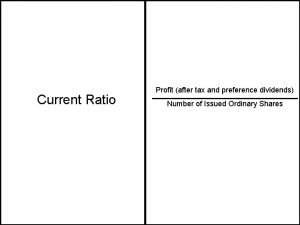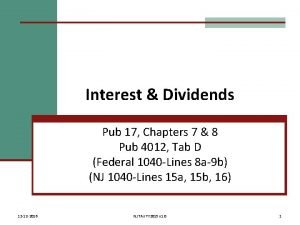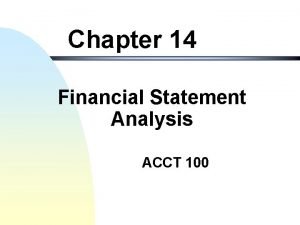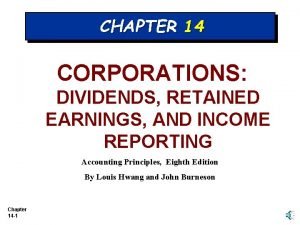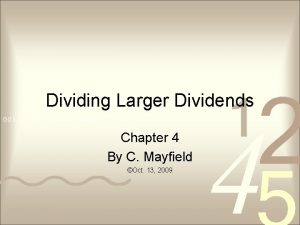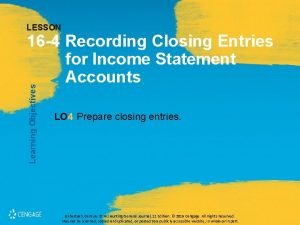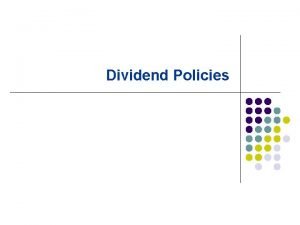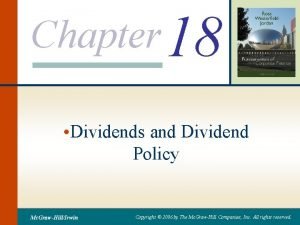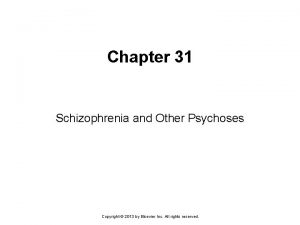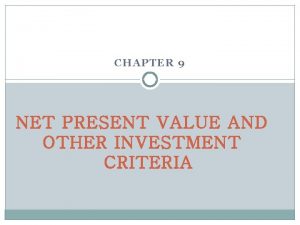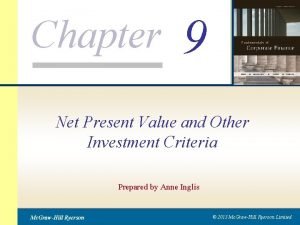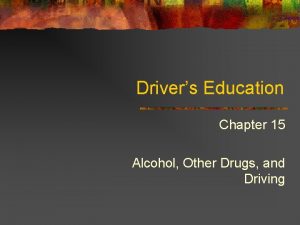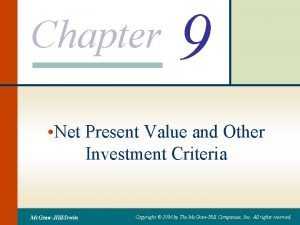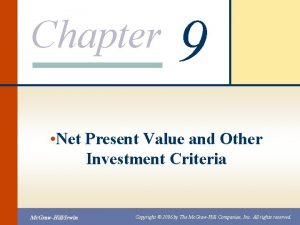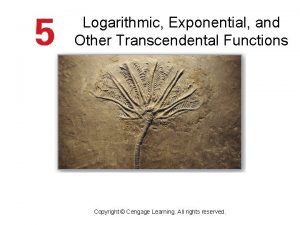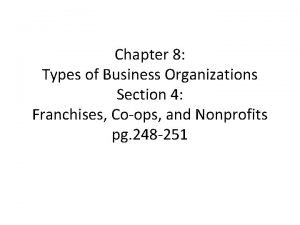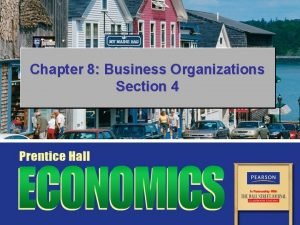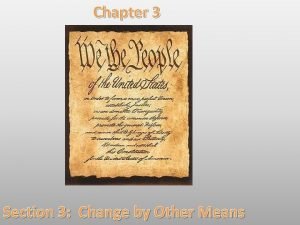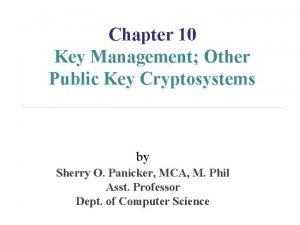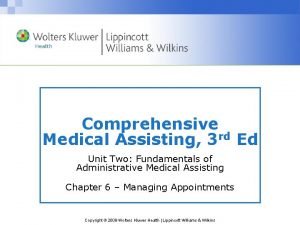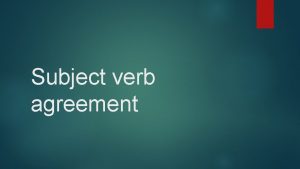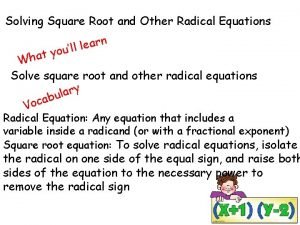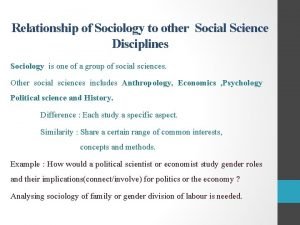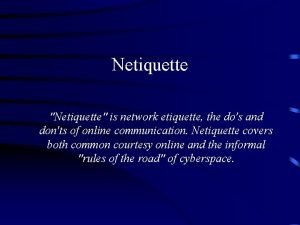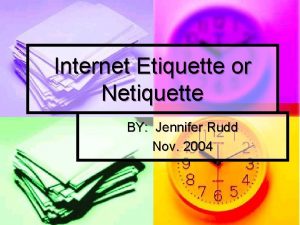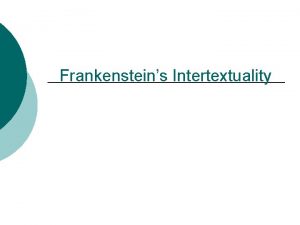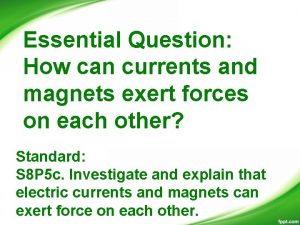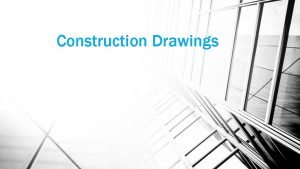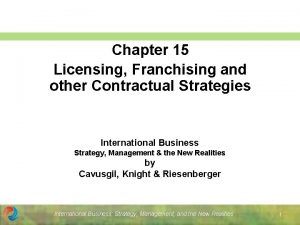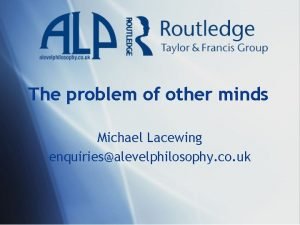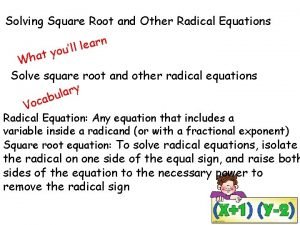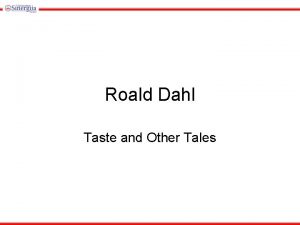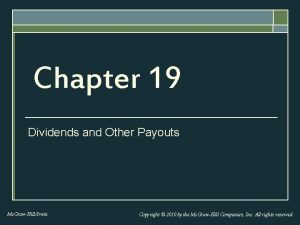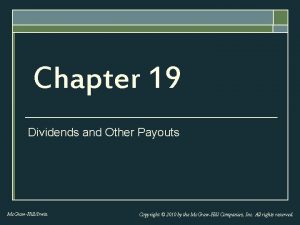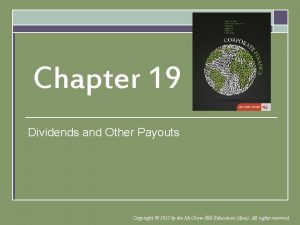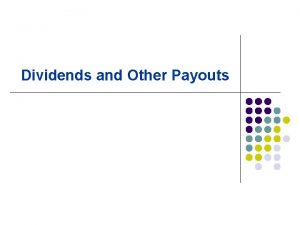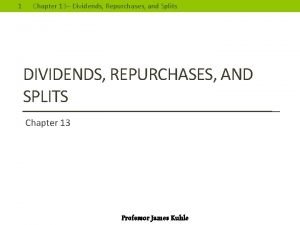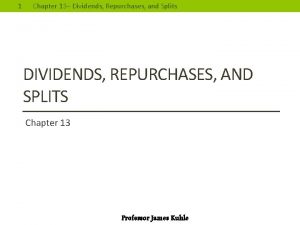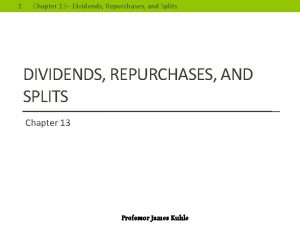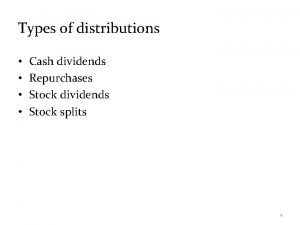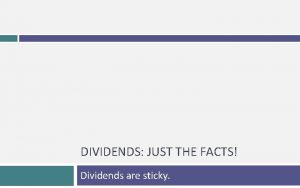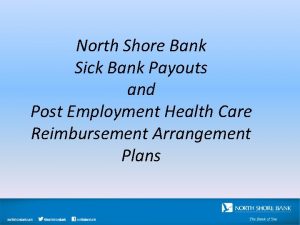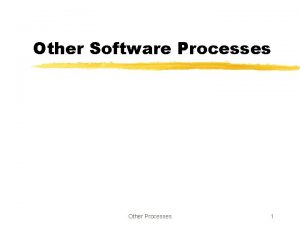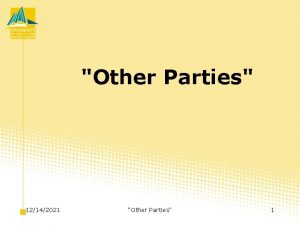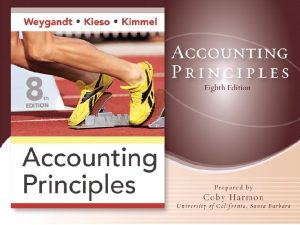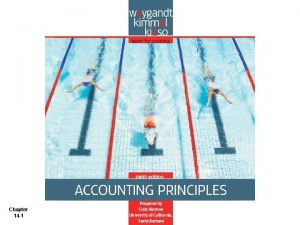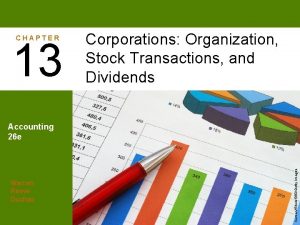Chapter 19 Dividends and Other Payouts 19 0















































- Slides: 47

Chapter 19 Dividends and Other Payouts 19 -0

Key Concepts and Skills • Understand dividend types and how they are paid • Understand the issues surrounding dividend policy decisions • Understand why share repurchases are an alternative to dividends • Understand the difference between cash and stock dividends 19 -1

Introduction What is dividend? Cash paid out of earnings. • If cash is paid from sources other than earnings, distribution rather than dividends is used. Distribution from earnings is dividend. 19 -2

Introduction �Corporations can return cash to their shareholders by various payout policies �How financial managers decide on the amount and form of payout? 19 -3

Different Types of Payouts • In form of cash: Types of cash dividends Ø Regular cash dividends Ø Extra dividends Ø Special dividends Ø Liquidating dividends • Alternatives to cash dividends: Ø Stock dividend Ø Stock repurchase Ø Stock split 19 -4

Dividends in the form of cash • Regular cash dividend – normal dividends, usually paid on a quarterly basis. • Extra cash dividend or Special dividend – paid over and above the regular dividend, may or may not be repeated. Occurs typically: ØWhen a company has exceptionally strong earnings that it wishes to distribute to shareholders. Øor when it wishes to make changes to its financial structure (moving to more debt-based). • Liquidating dividends: when some or all of the business has been liquidated (sold off). 19 -5

Alternatives to cash dividends • Companies will often declare stock dividends. ØNo cash leaves the firm. ØThe firm increases the number of shares outstanding, reducing the value of each share. ØExpressed as a percentage: for example, with a 2% stock dividend a shareholder receives 1 new share for every 50 currently owned. • Other companies use stock buybacks (repurchase). ØInstead of using cash to pay dividends, firm may use cash to buy back some shares (treasury stock). • Stock split ØThe firm increases the number of shares outstanding, reducing the value of each share. 19 -6

Standard Method of Cash Dividend • The decision to pay dividends rests in the hands of the board of directors. • When a dividend has been declared, it becomes a debt (obligation) of the firm and cannot be rescinded easily. • Commonly, the amount of cash dividend is expressed in terms of dollars per share (dividends per share). • Dividend can be also expressed as a percentage of the market price (dividend yield) or as a percentage of net income or EPS (dividend payout). • The mechanism of paying dividends is illustrated in the following figure: 19 -7

Standard Method of Cash Dividend 25 Oct. 2 Nov. 5 Nov. 7 Dec. … Declaration Date Ex. The stock is trade dividend cum dividend Date Record Date Payment Date Declaration Date: On Oct 25, the Board of Directors declares a payment of dividends. Ex-Dividend Date: If purchase the stock on or after, receive no dividend. occurs 2 -3 days prior to the Record day. Record Date: The corporation prepares a list of all individuals believed to be stockholders as of 5 November. Payment Date: Checks are mailed. 19 -8

Standard Method of Cash Dividend Declaration Date - The Board of Directors declares a payment of dividends. Ex-Dividend Date - Date that determines whether a stockholder is entitled to a dividend payment; anyone holding stock immediately before this date is entitled to a dividend. . It is 2 -3 business days before date of record. If you buy stock before this date, you are entitled to dividends. Record Date – Date on which company determines existing shareholders. Payment Date – Dividend checks are mailed. 19 -9

Ex-dividend date - Price Behavior • In a perfect world, the stock price will fall by about the amount of the dividend on the ex-dividend date. -t … -2 -1 0 $P +1 The price drops by the amount of the cash dividend. +2 … $P - div Exdividend Date • The key world here is about. Because dividends are taxed, the actual price drop is less than the dividends. Taxes complicate things a bit due to different tax rates and rules for different buyers. 19 -10

Does Dividend Policy Matter? • To decide whether or not dividend policy matter to investors, we first have to define dividend policy. • Dividends are paid in cash, and cash is something that everybody likes. • The question will be then is whether the firm should pay out cash now or invest cash and pay it out later. • Therefore, dividend policy is the time pattern of dividend payout. • Should the firm pay out large percentage of its earnings now or small (or even zero) percentage? • This is the dividend policy question. 19 -11

The Irrelevance of Dividend Policy • A compelling case can be made that dividend policy is irrelevant (MM). • Since investors do not need dividends to convert shares to cash; they will not pay higher prices for firms with higher dividends. • In other words, dividend policy will have no impact on the value of the firm because investors can create whatever income stream they prefer by using homemade dividends. 19 -12

The Irrelevance of Dividend Policy • Example: Ø Bianchi Inc. is a $42 stock. Ø Bob is an investor owns 80 shares in Bianchi Inc. and prefers a $3 dividend. Ø Bianchi Inc. is about to pay a $2 cash dividend. Ø Will Bob be unsatisfied to the Bianchi Inc. ’s dividend policy? 19 -13

The Irrelevance of Dividend Policy • If the firm pays dividend of $3 per share. After the ex-dividend date, the shares of the company will be at a price at $39 i. e. after deducting the dividend from the price of the shares. • Thus, the investor will have $240 as dividend and 80 shares @ $39 making his shareholding at $3120. 19 -14

The Irrelevance of Dividend Policy • Here the investor prefer to receive cash of $240. If the firm pays $2, he will receive $160 as dividends which is less by desired cash by $80. However, he can generate this difference by selling shares exdividend. He can sell 2 shares at $40 and generate $80 so in total he receives $240 (homemade dividend). The investor is left with $3120 of shareholding after he sold the shares. • The investor had an objective to generate $240 as cash. Thus, the dividend policy of Bianchi did not affect the investor from taking a “homemade dividend”. 19 -15

The Irrelevance of Dividend Policy • Bob’s homemade dividend strategy: selling shares in the appropriate proportion to create an equivalent cash flow to receiving the dividend stream you want. Ø Sell 2 shares ex-dividend $3 Dividend homemade dividends Cash from dividend $240$160 Cash from selling$0 stock $80 Total Cash $240 Value of Stock Holdings $39 × 80 = $40 × 78 = $3, 120 19 -16

The Irrelevance of Dividend Policy • In the above example, Bob Investor began with a total wealth of $3, 360: · After a $3 dividend, his total wealth is still $3, 360: · After a $2 dividend and sale of 2 ex-dividend shares, his total wealth is still $3, 360: 19 -17

The Irrelevance of Dividend Policy • Note that the value of the stock is the present value of expected future dividends. • The dividend growth model: P 0 = D 1 / (RE – g). ØIn the absence of market imperfections, it can be shown that an increase in the future dividend, D 1, will reduce earnings retention and reinvestment. ØThis will reduce the growth rate, g. Therefore, both the numerator and the denominator increase, and the net effect on P 0 is canceled out. 19 -18

The Irrelevance of Dividend Policy • Since the payout policy is irrelevant, firms should never forgo positive NPV projects (which increase the firm’s value) to increase a dividend (or to pay a dividend for the first time). • This idea was implicitly considered by Miller and Modigliani (MM). One of the assumptions underlying their dividend irrelevance argument is: “The investment policy of the firm is set ahead of time and is not altered by changes in dividend policy. ” 19 -19

Repurchase of Stock • Instead of declaring cash dividends, firms can rid themselves of excess cash through buying shares of their own stock. • Recently, share repurchase has become an important way of distributing earnings to shareholders. • Three ways for share repurchases: ØOpen market purchases: firm purchases their own stock just like anyone. Here the firm does not reveal itself as the buyer. ØTender offer: the firm announces to all of its stockholders that it is willing to buy a fixed number of shares at a specific price. ØTargeted repurchase: firm repurchases shares from specific individual stockholders. 19 -20

Stock Repurchase versus Dividend Consider a firm that wishes to distribute $100, 000 to its shareholders. Its equity has a market value equals to its book value. A. Original Balance Sheet Assets Liabilities & Equity Cash $150, 000 Debt 0 Other Assets 850, 000 Equity 1, 000, 000 Value of Firm 1, 000 Shares outstanding = 100, 000 Price per share = $1, 000/100, 000=$10 19 -21

Stock Repurchase versus Dividend If they distribute the $100, 000 as a cash dividend, the balance sheet will look like this: B. Balance sheet after $1 per share cash dividend Assets Liabilities & Equity Cash $50, 000 Debt Other Assets 850, 000 Equity Value of Firm 900, 000 0 900, 000 Value of Firm 900, 000 Shares outstanding = 100, 000 Price per share = $900, 000/100, 000 = $9 19 -22

Stock Repurchase versus Dividend If they distribute the $100, 000 through a stock repurchase, the balance sheet will look like this: C. Balance sheet after stock repurchase Assets Liabilities & Equity Cash $50, 000 Debt 0 Other Assets 850, 000 Equity 900, 000 Value of Firm 900, 000 Shares outstanding= 90, 000 Price pershare = $900, 000 / 90, 000 = $10 19 -23

Stock Repurchase • Example: • A firm has a market value equal to its book value. Currently, the firm has excess cash of $600 and other assets of $5, 400. Equity is worth $6, 000. The firm has 500 shares of stock outstanding and net income of $900. What will the new earnings per share be if the firm uses its excess cash to complete a stock repurchase? Price per share = $6, 000 ÷ 500 = $12 Number of shares repurchased = $600 ÷ $12 = 50 shares New EPS = $900 ÷ (500 - 50) = $2. 00 19 -24

Stock Repurchase versus Dividend • Why do some firms choose repurchases over dividends? • Flexibility for shareholders: Ø dividends represent commitment whereas repurchases do not. Thus, firms with permanent increase in cash flows is likely to increase dividends. However, firms with temporary increase in cash flow is likely to repurchase shares. • Keeps stock price higher Ø Stock price tends to be greater after a repurchase than after a dividend. Ø Good for insiders who hold stock options • As an investment of the firm (undervaluation) Ø Some companies repurchase their shares when they believe that it is undervalued. • Tax benefits Ø Share repurchases provide a tax advantage over dividends. 19 -25

Personal Taxes, Dividends and Stock Repurchases • To get the result that dividend policy is irrelevant, we needed three assumptions: ØNo taxes ØNo transactions costs ØNo uncertainty • Now, we are going to examine the effect of taxes on both dividends and repurchases. • Our discussion is facilitated by classifying firms into two types: (1) those without sufficient cash to pay dividends and (2) those with sufficient cash to do so. 19 -26

Firms without Sufficient Cash • Assume that a firm without cash that is owned by a single investor. If this firm wish to pay a dividend of $100, • it must raise capital. • The firm might choose among stock or bond issues to pay the dividend. • For simplicity, we assume that investor get cash to the firm by issuing stock. • Now assume that dividends are taxed at the owner’s personal tax rate of 15%. • The firm will receive $100 upon issuance of stock. However, the investor does not get the full $100 dividend. Instead dividend payment is taxed and hence investor receive s only $85. the investor loses $15. • In a world of personal taxes, firms should not issue stock to pay a dividend. 19 -27

Firms without Sufficient Cash Investment Bankers Cash: stock issue Firm The direct costs of stock issuance will add to this effect. Stock Holders Cash: dividends Taxes Gov. 19 -28

Firms with Sufficient Cash • The above argument does not necessarily apply to firms with excess cash. • Consider a firm that has extra cash after selecting all available positive NPV projects. The firm might consider the following alternative to a dividend. ØSelect additional capital budgeting projects (by assumption, these are negative NPV). ØAcquire other companies ØPurchase financial assets ØRepurchase shares 19 -29

Firms with Sufficient Cash • Let us go back to our example in which the firm wish to distribute $100 to shareholders but now using its extra cash. • Here the shareholder will receive $100 from selling shares to the firm. • Assume that the shareholders originally bought these sold shares for $40. • The shareholder’s capital gain = $100 -$40= $60. • The shareholder will pay a tax of 15%, so taxes paid =$60*(1 - 0. 15)= $9. • This amount is less than the taxes paid on dividends which is the income for the shareholders. • The tax paid from a repurchase is less than the tax paid on a dividend. 19 -30

Taxes and Dividends • In the presence of personal taxes: 1. A firm should not issue stock to pay a dividend. 2. Managers have an incentive to seek alternative uses for funds to reduce dividends. 3. Though personal taxes mitigate against the payment of dividends, these taxes are not sufficient to lead firms to eliminate all dividends. The question now, in the presence of personal taxes, why do firms still pay dividends instead of other alternatives? 19 -31

Real-World Factors Favoring High Dividends • Reasons why a firm might pay its shareholders high dividends even in the presence of personal taxes on these dividends: Ø Desire for Current Income. Ø Behavioral Finance. • It forces investors to be disciplined. Ø Agency Costs. • High dividends reduce free cash flow. Ø Dividend signaling. • Dividends provide signal that firm is going to do well in future. 19 -32

Desire for current income • Many individuals desire current income, for example retired people and others living on fixed income. • This argument states that these individuals would bid up (down) the stock price if dividends increase (fall). • However, in perfect capital market, individuals preferring high current cash flow, but holding low-dividend securities could easily sell off shares to provide the necessary funds. • Thus, in a world of no transaction costs, a high-current – dividend policy would be no value to the stockholders. • However, in real world, stock sales involves brokerage fees and other transaction cost that could be avoided by investing in high-dividends securities. 19 -33

Behavioral Finance • The basic idea here concerns a concept of selfcontrol, has an emphasis in finance? • Behavioral finance argues that Øinvestors with high self-control can invest in nodividend stocks and sell off necessary stocks each year for consumption. ØBut if investor lacks self-control, he might sell off too much leaving little for later years. Ø limited self-control can meet current consumption needs via high –dividend stocks while adhering to policy of “never dipping into principal”. 19 -34

Agency costs • Different stakeholders have different goals. Bondholders would like cash to stay in the firm so that cash would be available to pay bondholders during times of financial distress. However, stockholders would like to keep extra cash for themselves. Managers also may pursue selfish goals with firm has extra cash. • Here comes the role of dividends decrease free cash flows that might be used by managers in negative ways. • Managers, acting on behalf of stockholders, can pay dividends to keep cash from bondholders. • The board of directors, also acting on behalf of stockholders, can use dividends to reduce the cash available to spendthrift managers. • The presence of agency cost is not an argument for dividends over repurchases. 19 -35

Information content of dividends and dividend signaling • The stock market reacts positively to increases in dividends (or an initial payment), and negatively to decrease in dividends. • Stock price rises when a firm announces a dividend increase and falls when it announces a dividend decrease. • This suggest that there is information content in dividend payments. • So dividends can be used as a signal to the market that the firm is expected to do well in the future. As firms will increase dividends only if they expect earnings and cash flows to increase (dividend signaling) • Could management increase dividends just to make the market think that the cash flows will be higher, even when it will not rise? 19 -36

The Clientele Effect • So far, we pointed out that the existence of personal taxes favors the payment of low dividends, whereas other factors favor high dividends. • The financial profession had hoped that it would be easy to determine which set of factors dominates. However, after many years of research, no one has been able to conclude which one is more important. • However, one particulate idea known as the clientele effect implies that the two sets of factors are likely to cancel each other. • The clientele effect separates investors into different categories (clienteles). Each category has different preference for dividends. 19 -37

The Clientele Effect • Clienteles for various dividend payout policies are likely to form in the following way: Group Stock Type High Tax Bracket Individuals Zero-to-Low payout Low Tax Bracket Individuals Low-to-Medium payout Tax-Free Institutions Medium payout Corporations High payout Once the clienteles have been satisfied, a corporation is unlikely to create value by changing its dividend policy. 19 -38

Dividends: What We Know • Corporations “smooth” dividends. ØIt is when firms keep dividends fixed relative to Earnings and that dividends are paid at a stable rate • Fewer companies are paying dividends. ØThe percentage of firms paying dividends has fallen over the last few decades due to increase in small, unprofitable firms. • Dividends provide information to the market. • Firms should follow a sensible policy: ØDo not forgo positive NPV projects just to pay a dividend. ØAvoid issuing stock to pay dividends. ØConsider share repurchase when there are few better uses for the cash. 19 -39

Dividends: Pros and Cons Pros Cons Dividends may appeal to investors who Dividends are taxed as income. desire stable cash flow but do not want to incur transaction costs from selling shares. Behavioral finance argues that investors with limited self-control can meet current consumption needs with high-dividend stocks. Dividends can reduce internal sources of financing. Dividends may force firm to forgo positive NPV projects and to rely on external financing. Dividends may be paid in order to keep Once established, dividend cuts are cash from bondholders. hard to make without negatively affecting share price. Dividends may be paid to reduce cash available to spendthrift managers. Dividends may be used to signal optimism concerning future cash flows. 19 -40

Stock Dividends • • Pay additional shares of stock instead of cash Increases the number of outstanding shares The result is that each stock is worth less Expressed as a percentage Ø If you own 100 shares and the company declared a 10% stock dividend, you would receive an additional 10 shares. • Small stock dividend Ø Stock dividends of less than 20 to 25% • Large stock dividend Ø Stock dividends of more than 20 to 25% 19 -41

Stock Dividends • Example: • Peterson Co. has 10, 000 shares outstanding, each selling at $66. The equity portion of Peterson’s balance sheet is as follows: Common stock Surplus account Retained earnings Total owners’ equity $10, 000 $200, 000 $290, 000 $500, 000 The company declares a 10% stock dividend. How Peterson’s balance sheet will change? 19 -42

Stock Dividends • So 1000 new shares are issued at par. Then the common stock account is increased by $1000 for a total of $11, 000. • The market price is $66 which is $65 higher than par value, so the excess of $65*1000 shares=$65, 000 is added to the capital surplus account, producing a total of $265, 000. • The owners’ equity is unaffected by stock dividend because no cash has come in or out, so retained earnings are reduced by the entire $66, 000, leaving $224, 000. the net effect of stock dividend on Peterson’s equity account is : Common stock $11, 000 Surplus account $265, 000 Retained earnings $224, 000 Total owners’ equity $500, 000 19 -43

Stock Splits • Stock splits – essentially the same as a stock dividend except it is expressed as a ratio instead of percentage Ø For example, a 2 for 1 stock split is the same as a 100% stock dividend. Ø It means that each old share is spilt into two new shares (shares are doubled). Ø Par value of each stock is reduced by the half. • Stock price is reduced after the stock splits. • Common explanation for split is to return price to a “more desirable trading range. ” 19 -44

Stock Splits • Example: • Suppose Peterson decides to declare a two-forone stock split. • The number of shares will double to 20, 000 and the par value will be halved to $0. 5 per share. The owners’ equity after the split is: Common stock Surplus account Retained earnings Total owners’ equity $10, 000 $200, 000 $290, 000 $500, 000 19 -45

Reverse split • Reverse split: shares are merged to form a smaller number of proportionally more valuable shares. • Example: • 1 -for-6 stock split • Reasons for reverse split • Transaction costs to shareholders may be less after the reverse split. • Liquidity and marketability of stock may improved after the reverse split. • Reverse split may bring share price to acceptable level. 19 -46
 Keno 603 winning numbers
Keno 603 winning numbers Net profit after tax and preference dividends
Net profit after tax and preference dividends Private activity bond interest dividends
Private activity bond interest dividends Dividends of workplace diversity
Dividends of workplace diversity Record date ex dividend date
Record date ex dividend date Acct 100
Acct 100 Dividend payable journal entry
Dividend payable journal entry How can i divide larger dividends
How can i divide larger dividends Record the closing entry for dividends
Record the closing entry for dividends Homemade dividend example
Homemade dividend example Compromise dividend policy
Compromise dividend policy Types of position
Types of position Drinking black coffee drivers ed
Drinking black coffee drivers ed Chapter 31 schizophrenia and other psychoses
Chapter 31 schizophrenia and other psychoses Chapter 9 net present value and other investment criteria
Chapter 9 net present value and other investment criteria Net present value and other investment criteria
Net present value and other investment criteria Chapter 15 alcohol other drugs and driving
Chapter 15 alcohol other drugs and driving Advantage and disadvantage of npv
Advantage and disadvantage of npv Chapter 9 net present value and other investment criteria
Chapter 9 net present value and other investment criteria Chapter 15 alcohol other drugs and driving
Chapter 15 alcohol other drugs and driving Existence of inverse function
Existence of inverse function Chapter 11 real estate and other investments
Chapter 11 real estate and other investments Chapter 8 section 4
Chapter 8 section 4 Chapter 8 business organizations
Chapter 8 business organizations Chapter 42 assisting in other medical specialties
Chapter 42 assisting in other medical specialties Change by other means
Change by other means Chapter 10: other public-key cryptosystems
Chapter 10: other public-key cryptosystems Chapter 11 section 3 the implied powers answer key
Chapter 11 section 3 the implied powers answer key Chapter 42 assisting in other medical specialties
Chapter 42 assisting in other medical specialties Bipolar and other related disorders
Bipolar and other related disorders Bipolar and other related disorders
Bipolar and other related disorders Margo and her parents visit each other often
Margo and her parents visit each other often Solving square root and other radical equations quick check
Solving square root and other radical equations quick check Social science and sociology
Social science and sociology Benefits of netiquette
Benefits of netiquette Two vocal styles of singing in pakistan
Two vocal styles of singing in pakistan Netiquette
Netiquette Gazelle symbiotic relationship
Gazelle symbiotic relationship Intertextuality
Intertextuality Explain how currents and magnets exert forces on each other
Explain how currents and magnets exert forces on each other The information needed to identify lines and other symbols
The information needed to identify lines and other symbols What's the
What's the Licensing franchising and other contractual strategies
Licensing franchising and other contractual strategies Topic 2 free enterprise and other economic systems
Topic 2 free enterprise and other economic systems Water soluble vitamins characteristics
Water soluble vitamins characteristics Other minds problem
Other minds problem How to solve square root equations
How to solve square root equations Taste and other tales summary
Taste and other tales summary

